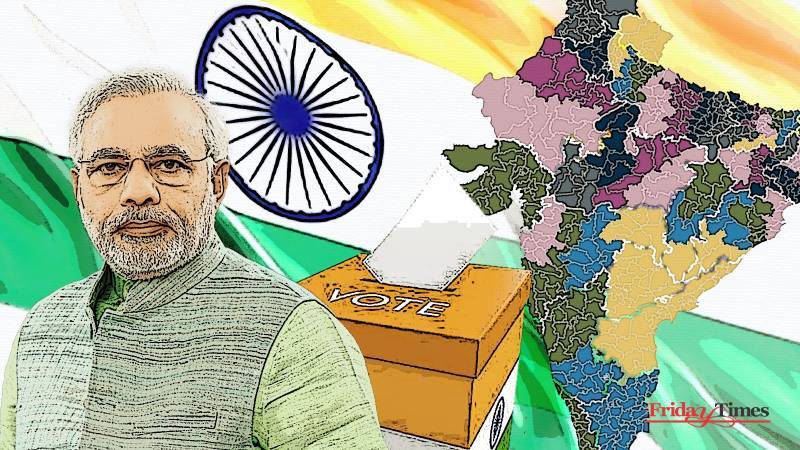
One wonders if the recent exchange of 'X' (formerly known as Twitter) posts between Prime Minister Shehbaz Sharif and his Indian counterpart, Narendra Modi, tended towards curt snubs more than felicitations. The response to Nawaz Sharif's effusive congratulatory message was not much different: Modi returned the compliments by harping on the same old string of security. While the scene at the top appears the same, the case seems reversed: the more things stay the same, the more they change.
This time, Prime Minister Modi 3.0 may not be the same as before. His unique campaign to win over Hindu votes by targeting Muslims followed the trajectory of an avowed policy. Adding fuel to the fire and tapping the undercurrents of hatred nurtured by communal forces, BJP leaders banked upon their Hindutva agenda without considering how far they were carrying toxic matters. This scared away even those Hindu voters who are attached to a pluralistic and secular ethos, not to speak of the Muslims.
The notable achievements he made, mostly in the economic field, ultimately took Modi to the victory stand. Despite this, the challenges of rising inflation, high unemployment, rural economic suffering, and the grossly unequal distribution of national wealth did not leave him unscathed. The phenomenon of "Modi fatigue" also weighed in. The Indian people, therefore, deemed it fit to cut him to size to safeguard their constitution, democracy and state institutions. While they have returned Modi to power, this is not the same Modi who went into elections dreaming of securing 400 seats. This Modi is bereft of a clear mandate and needs the crutches of allies to stay in the top slot. The charismatic authoritarianism streak that defined his decade-long tenure may now stand disrupted, no more an avatar. The people's message to Modi is clear: they disapprove of his actions, agenda, governance and campaign.
While the Indian people have chosen their government, this time, they have chosen the opposition too: as a part of course correction and necessary balance. Modi, over his decades of power (first in the province of Gujarat and then in the centre), remained alien to the true spirit of democracy and pluralism. Looking at his political career starting in Gujarat state, his governance style focused on his charisma and dynamism, overshadowing party principles. When he headed a government in Delhi, it was still very much a Modi government, not a BJP one; when he ran an election campaign, it was the "Modi guarantee" campaign spiked with the mist of communal hatred. The Indian people feared that their country was on its way to becoming another dystopian regime of Orwell's 1984 and Animal Farm put together.
The Indian people deemed it fit to cut Modi to size and safeguard their constitution, democracy and state institutions
With coalition partners on the left and right to support his survival, Modi is to taste the real essence of democracy and to head a real NDA government, not that of the BJP alone. His ambition has been curtailed, and his anti-Muslim stance faces challenges where his partners rely on Muslim votes and believe in secularism and inclusivity. The TDP announced positive steps and plans for the economic and social development of Muslims in Andhra Pradesh, in addition to a 4% reservation for Muslim representation and subsidy on Hajj.
Critics now doubt his ability to adapt and maintain coalition harmony: it is unlikely that Modi will adjust himself the way he has to if he wants to continue as prime minister and keep swallowing the bitter pills of holding his coalition together. Once the honeymoon phase passes, confronting the unending wish list of his coalition partners like Bihar's Nitish Kumar and Andhra Pradesh's Chandrababu Naidu may stare him in the face, the wily and ambitious ones with totally different mindsets. They know when to move forward and when to withdraw, and they have the capacity, experience, and skill to outplay Modi; they can thus wear him out. Such things will test the skills that Modi woefully lacks.
Old Modi is now required to invent a new Modi. He has to struggle against his characteristic traits, or elements of coalition unsustainability may creep in. The sort of demands emerging from his allies go against the grain of his way of doing politics; his partners may also not be ready to play second fiddle to Modi.
One thing is clear: the era of BJP's anti-Muslim rhetoric, of their organised violence and bulldozers, seems to have faded away. Modi tarred the whole election campaign with a brush of Hindu-Muslim clash. Having lost more than 70 seats, this fear now dissipates with an audible sigh of relief. As for the economic front, supporters fear that if Modi couldn't deliver his much-hyped prosperity at the ground level when it was a one-man show, how will he do so now when he has allies breathing down his neck all the time?

